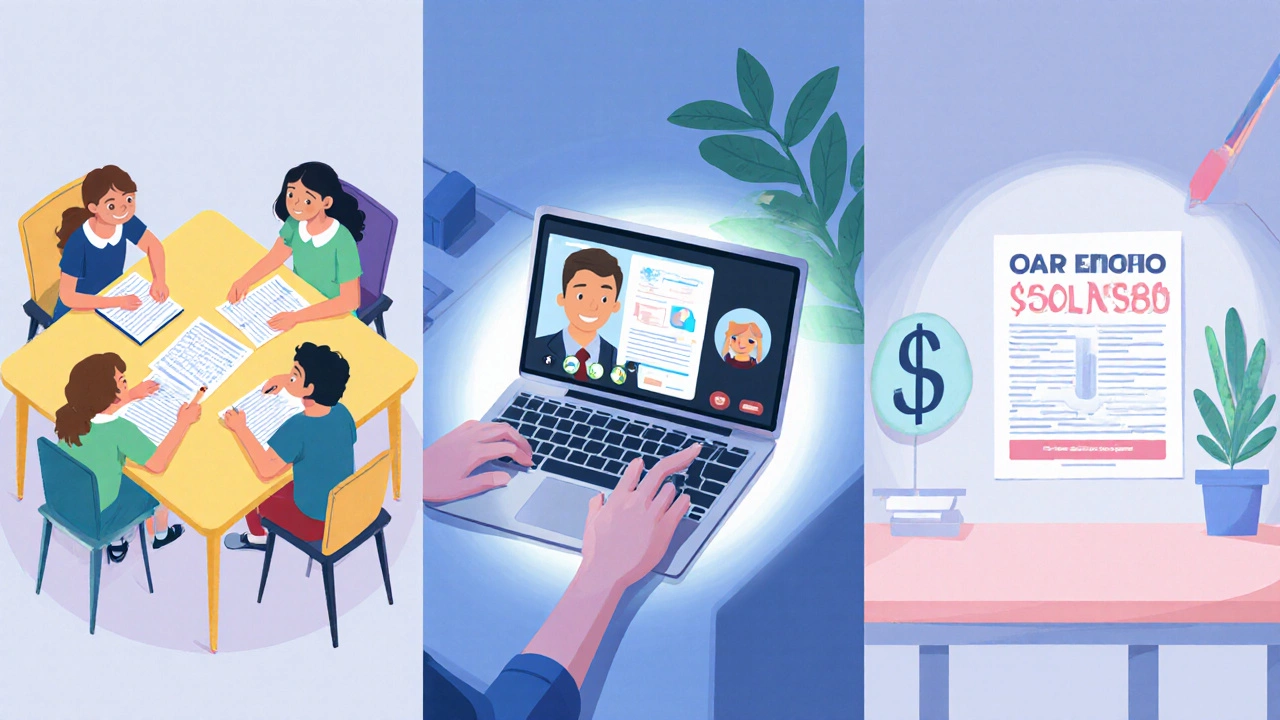Private Tutoring Cost Estimator
Estimate Your Tutoring Costs
Enter your tutoring preferences to get a personalized cost estimate based on Australian market rates.
Ever wonder why a single hour of private tutoring can feel like a small fortune? The answer isn’t a mystery - it’s a mix of qualifications, overhead, market forces, and hidden fees. Below we break down each cost driver so you can see exactly where that price tag comes from and how to make it work for you.
Key Takeaways
- Qualified tutors charge more because of training, experience, and certifications.
- Operating costs - rent, materials, insurance - add a steady baseline to every session.
- Supply and demand, especially in wealthy or competitive districts, push rates upward.
- Group tutoring, online platforms, and community programs can lower the private tutoring cost without sacrificing quality.
- Understanding hidden fees helps families budget more accurately.
What Actually Drives the Price?
When you see a tutor’s hourly rate, you’re looking at a sum of several components. Think of it like a pizza: the crust is the base expense (overhead), the sauce is the tutor’s expertise, and the toppings are the extra services such as travel or custom lesson plans. Each piece adds up, and the final price reflects the total.
1. Tutor Qualifications and Experience
Tutor is an individual who provides personalized instruction, typically holding a degree, teaching certification, or subject‑specific expertise. A tutor with a Master’s in Mathematics, years of classroom teaching, and a teaching credential can command 30‑50% higher rates than a recent college graduate with only a bachelor's degree. Certifications from bodies like the National Tutoring Association (NTA) or subject‑specific credentials (e.g., AP, IB) also act as quality signals that parents are willing to pay for.
Experience matters too. Tutors who have helped students achieve top percentile scores on standardized tests often build a reputation that lets them charge premium fees. That reputation isn’t free - it’s built on years of trial, error, and measurable outcomes.
2. Operating Expenses
Even a freelance tutor isn’t exempt from business costs. Below are the most common line items:
- Space Rental: A quiet room in a commercial center or a dedicated tutoring center often costs $200‑$600 a month in major Australian cities.
- Materials & Resources: Textbooks, software licenses (e.g., Mathematica, Adobe), and printed worksheets can total $50‑$150 per student each term.
- Insurance & Liability: Professional indemnity policies protect both tutor and family, typically $300‑$500 annually.
- Administrative Tools: Scheduling software, payment processing fees, and marketing (flyers, website hosting) add another $30‑$80 per month.
All these expenses are baked into the hourly rate to ensure the tutor covers overhead and earns a sustainable living.

3. Market Dynamics: Supply, Demand, and Location
The tutoring market behaves much like any other service economy. In high‑performing school districts of Adelaide, New South Wales, or Victoria, parental demand for top‑grade results spikes during exam seasons, pushing rates up by 20‑40% compared to regional areas. Conversely, in cities with a surplus of qualified tutors, competition can drive prices down.
Seasonality matters too. Rates often increase in the months leading up to the HSC, ATAR, or university entrance exams, then dip during school holidays when demand wanes.
4. Types of Tutoring and Their Price Points
Not all private tutoring is created equal. Understanding the format helps families choose the best value for their goals.
| Format | Typical Hourly Rate (AUD) | Pros | Cons |
|---|---|---|---|
| One‑on‑One In‑Person | $70‑$120 | Personalized focus, immediate feedback | Highest cost, travel time |
| Small Group (2‑4 students) | $45‑$80 | Lower per‑student cost, peer learning | Less individualized attention |
| Online Platform (live video) | $35‑$65 | Flexible scheduling, no travel | Requires reliable internet, less hands‑on |
| Pre‑Recorded Course | $10‑$30 per module | Most affordable, self‑paced | No live interaction, limited customization |
When budgeting, many families start with an online platform for core concepts, then supplement with in‑person sessions for tricky topics.
5. Hidden Costs You Might Overlook
Beyond the headline hourly rate, several extra fees can surprise parents:
- Travel Fees: Tutors who come to a student’s home often charge $10‑$20 per session for mileage.
- Cancellation Policies: A 24‑hour notice is standard; late cancellations can cost 50% of the session price.
- Materials Surcharge: Custom worksheets, diagnostic tests, or software licenses are sometimes billed separately.
- Premium Scheduling: Evening or weekend slots may carry a 10‑15% surcharge.
Understanding these add‑ons upfront can prevent budget blowouts.

6. How to Keep Private Tutoring Affordable
While private tutoring isn’t cheap, there are proven strategies to stretch every dollar:
- Leverage Group Sessions: Split a tutor’s time among 3‑4 students for a 30‑40% discount per child.
- Shop Around Early: Rates drop 5‑10% if you book a term‑long package before the exam season.
- Use Online Platforms: Services like Online tutoring platform offers live video lessons with qualified tutors at lower overhead, often matching or beating in‑person rates.
- Ask About Scholarships: Many community centres, universities, and even private tutoring companies run need‑based scholarships or discounted rates for low‑income families.
- Combine Resources: Pair a tutor with free resources such as Khan Academy, OpenStax, or government‑provided study guides.
- Negotiate Materials: Request digital copies instead of printed handouts to cut material fees.
7. The Role of Education Regulation and Parent Expectations
Education regulation is the set of laws and standards that govern how tutoring services operate, ensuring safety, quality, and consumer protection. In Australia, state boards require background checks and sometimes require tutors to hold a Working with Children Check (WWCC). These compliance steps add cost, but they also protect families and keep the market trustworthy.
Meanwhile, Parent expectation is the belief that private tutoring will guarantee better grades, exam success, or a competitive edge. This perception fuels demand, especially in high‑stakes academic environments, and consequently sustains higher price points.
Conclusion: Understanding the Value Behind the Price
Private tutoring isn’t a simple transaction; it’s an investment in expertise, resources, and market dynamics. By dissecting the cost structure-qualifications, overhead, supply-demand pressures, and hidden fees-you can make more informed choices. Whether you opt for group sessions, online platforms, or negotiate a package, knowing where the money goes empowers you to get the best learning outcomes without unnecessary expense.
Frequently Asked Questions
Why do some tutors charge more than others?
Rates reflect factors such as education level, certifications, years of experience, and the cost of living in a tutor’s location. Highly qualified tutors with proven exam success histories often command premium fees.
Can I negotiate a lower hourly rate?
Yes. Many tutors offer discounts for block bookings, group sessions, or off‑peak hours. It’s worth asking about package deals before committing.
What hidden fees should I watch out for?
Common extras include travel mileage, cancellation charges, material surcharges, and premium weekend or evening slots. Clarify all fees in the contract.
Is online tutoring cheaper than in‑person?
Generally, yes. Online platforms avoid rent and travel costs, so rates are usually 10‑30% lower. However, you still pay for the tutor’s expertise, so quality varies.
Are there any financial aid options for private tutoring?
Some community centres, universities, and tutoring companies run need‑based scholarships or discounted programs. Check local education departments and ask tutors directly about any assistance.

